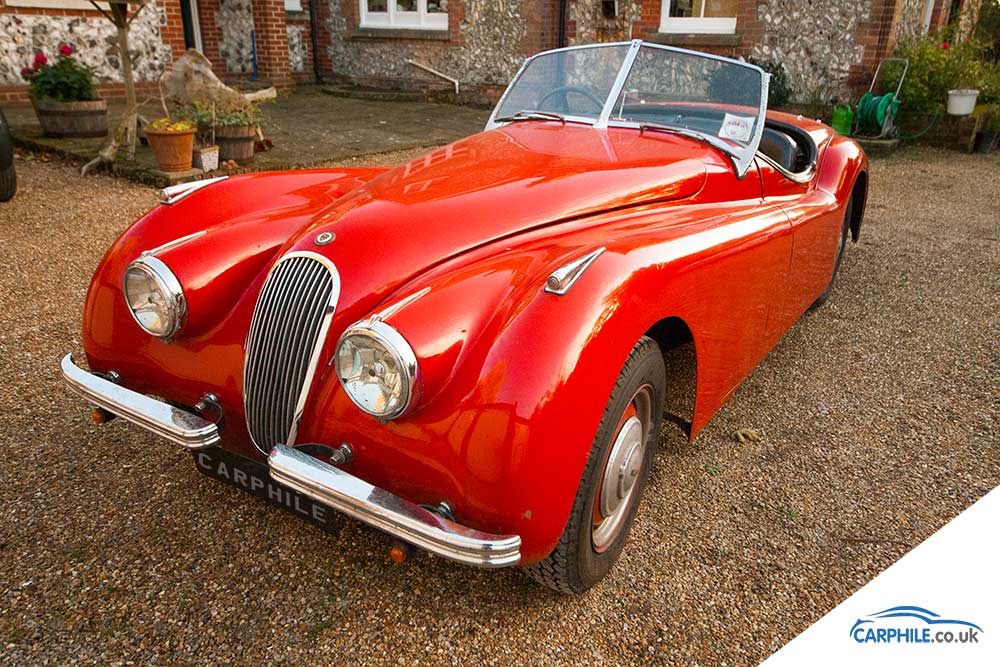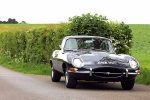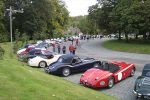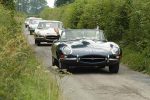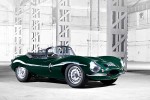1940s · Cars · Great Britain · Jaguar
Jaguar XK120 History
It’s difficult today to comprehend the impact the new Jaguar XK120 must have had on visitors to the 1948 Earls Court motor show as the covers were drawn back for the first time.
Jaguar XK120 History: launch
Jaguar’s competitors, still getting back on their feet after World War 2, were primarily displaying sports cars rooted in pre-war design and technology. The XK120’s streamlined shape and flowing curves must have looked like they came from another planet. But when Jaguar revealed the car was powered by an all-new twin-cam engine, was capable of over 120mph (making it the fastest production car in the world at the time) and would cost just £1263, they must have felt wanted to pack up and go home.
The XK120 cemented it’s star status and was very quickly the car to be seen driving. Famous XK120 owners were Clark Gable, Gary Cooper, Humphrey Bogart and Tyrone Power.
In post-war Britain the XK120 was a very important car for Jaguar. Around 60% of XKs were exported, helping Jaguar become Europe’s leading annual dollar earner for several years, until it was overtaken by Volkswagen.
Jaguar XK120 – Technology
At first Jaguar thought the XK120 would sell in small numbers, a glamorous model to show-off their new twin-cam XK engine. So the first 242 cars were built using bodywork constructed using the old-fashioned method of aluminium panels over a wooden-ash frame. Demand for the car was so strong that from the 1950 model year, body construction switched to the slightly heavier all-steel body construction, which would be easier to manufacture.
The new twin-cam XK engine had been developed in secret during the war. Straight-six in configuration, with alloy head and twin SU carburetors. It was an advanced engine in 1948 (At first, Jaguars own engineers doubted they could make the engine perform reliably) and would go on to power Jaguar’s into the nineteen eighties.
The XK120 sits on a shortened version of the Jaguar Mk V’s chassis, with independent torsion bar suspension at the front and semi-elliptic leaf springs at the rear. 12 inch drum brakes were fitted all-round an, like many at that time, were prone to fade. Although some cars were fitted with aluminium finned brake drums to help cool the brakes and overcome fade.
XK120 – performance:
The Jaguar XK120’s XK 6-cylinder engine was 3.4 litres in capacity, producing 160bhp and driven through a trusty 4-speed ‘Moss’ gearbox. The 1320kg car could cover 0-60 in 10 seconds and go on to a top speed of 120+mph (a figure that put the 120 in the XK120).
This top speed was soon put to the test in front of the press. In May 1959, Jaguar performed a number of top speed runs on a smooth stretch of Belgium motorway between Jabbeke and Ostend. By fitting the car with an aero screen and a few other small modifications, the car achieved a top speed of 135mph (with a jerry can of petrol in the boot to help balance the car above 125mph).
XK120 in Motorsport:
Drivers achieved considerable motorsport success behind the wheel of Jaguar XK120’s.
In July 1949 three XK120’s were entered into first big UK motor race since the war at Silverstone. The rest of the field didn’t see which way the cars driven by Leslie Johnson and Peter Walker went. Johnson won the event and went on to enter an XK120 into the Le Mans 24 hour race in 1950, the near standard car ran in third place before retiring with brake and clutch problems.
A year later a Jaguar C-Type (a racing car originally based on the XK120) set the record straight, triumphing in the famous French endurance race (and again in 1953).
In rallying, Ian Appleyard’s XK120 (NUB 120) won the Alpine and RAC rallies twice and the Tulip rally once, as well as many other events. The car would go on to cover more than 100,000 miles, was co-driven by Appleyard’s wife, Sir William Lyons’ daughter Pat. NUB 120 is still owned by Jaguar today and can be seen regularly at historic motorsport events such as the Goodwood Festival of Speed.
XK120 variants:
The XK120 was available in three versions. As a 2-seater roadster from launch, Jaguar released a fixed head coupe (FHC) in 1951 and a drophead coupe (DHC) with a more conventional folding convertible roof in 1953.
Jaguar toyed with the idea of producing a XK100, with a 2-litre 4 cylinder version of the XK engine but the car was cancelled before it made production.
Jaguar XK120 – Legacy
The real legacy of the XK120 is not the car itself but arguably the XK 6 cylinder (XK6) engine the car helped to launch.
The XK6 engine not only powered Jaguar’s Le Mans-winning C-types and D-types but also the compact and luxury saloons of the ’50s, fire engines, armoured vehicles, record-breaking power boats and the Jaguar E-type. The engine lived on for decades and was only being replaced in 1992.
Jaguar XK120 was followed up in 1954 by the XK140 and XK150 in 1957.



